Whirlpool GGW9250SU Owner's Manual

®
®
ELECTRONIC
GAS DRYER
Use&CareGuide
In the U.S.A., for questions about features, operation/ performance, parts, accessories or service call:
1-800-253-1301
In Canada, for assistance, installation and service call:
1-800-807-6777
or visit our website at... www.whirlpool.com or www.whirlpool.ca
SÉCHEUSE À GAZ ELECTRONIQUE
Guided’utilisationetd’entretien
Pour assistance, installation ou service composez
1-800-807-6777
ou visitez notre site web à www.whirlpool.ca
Table of Contents/Table des matières......................... |
2 |
W10049550
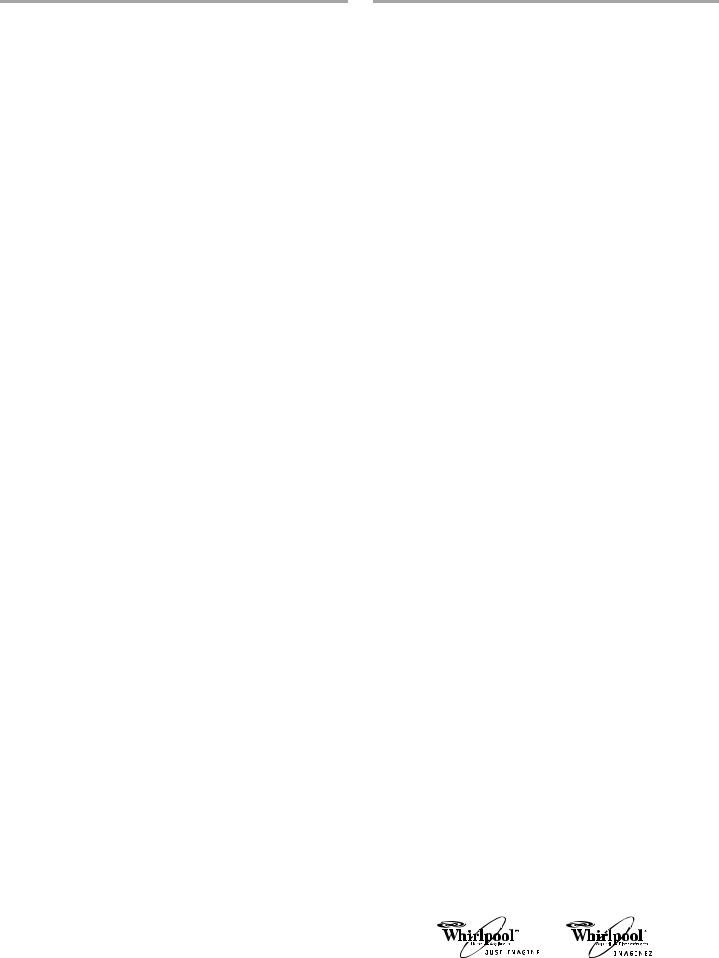
TABLE OF CONTENTS |
|
DRYER SAFETY.............................................................................. |
3 |
INSTALLATION INSTRUCTIONS .................................................. |
5 |
Tools and Parts ............................................................................ |
5 |
Options......................................................................................... |
5 |
Location Requirements ............................................................... |
6 |
Electrical Requirements ............................................................... |
8 |
Gas Supply Requirements ........................................................... |
8 |
Venting Requirements.................................................................. |
9 |
Plan Vent System....................................................................... |
10 |
Install Vent System..................................................................... |
12 |
Install Leveling Legs................................................................... |
12 |
Level Dryer ................................................................................. |
12 |
Make Gas Connection ............................................................... |
12 |
Connect Vent.............................................................................. |
13 |
Complete Installation ................................................................. |
13 |
DRYER USE .................................................................................. |
14 |
Starting Your Dryer..................................................................... |
14 |
Stopping Your Dryer .................................................................. |
15 |
Pausing or Restarting................................................................. |
15 |
Control Locked........................................................................... |
15 |
Drying and Cycle Tips................................................................ |
15 |
Status Lights .............................................................................. |
16 |
Cycles......................................................................................... |
16 |
Additional Features .................................................................... |
17 |
Drying Rack................................................................................ |
18 |
DRYER CARE .............................................................................. |
19 |
Cleaning the Dryer Location ...................................................... |
19 |
Cleaning the Lint Screen............................................................ |
19 |
Cleaning the Dryer Interior ......................................................... |
19 |
Removing Accumulated Lint...................................................... |
19 |
Vacation and Moving Care......................................................... |
20 |
Changing the Drum Light........................................................... |
20 |
TROUBLESHOOTING .................................................................. |
20 |
ASSISTANCE OR SERVICE......................................................... |
22 |
WARRANTY .................................................................................. |
23 |
TABLE DES MATIÈRES |
|
SÉCURITÉ DE LA SÉCHEUSE .................................................... |
24 |
INSTRUCTIONS D’INSTALLATION............................................. |
26 |
Outillage et pièces...................................................................... |
26 |
Options ....................................................................................... |
26 |
Exigences d’emplacement......................................................... |
27 |
Spécifications électriques .......................................................... |
29 |
Alimentation en gaz.................................................................... |
30 |
Exigences concernant l'évacuation ........................................... |
31 |
Planification du système d’évacuation ...................................... |
32 |
Installation du système d’évacuation......................................... |
34 |
Installation des pieds de nivellement......................................... |
34 |
Mise à niveau de la sécheuse .................................................... |
35 |
Raccordement au gaz ................................................................ |
35 |
Raccordement du conduit d’évacuation ................................... |
35 |
Achever l’installation .................................................................. |
36 |
UTILISATION DE LA SÉCHEUSE................................................ |
37 |
Mise en marche de la sécheuse ................................................ |
37 |
Arrêt de la sécheuse................................................................... |
38 |
Mise en pause ou remise en marche......................................... |
38 |
Verrouillage des commandes..................................................... |
38 |
Conseils pour le séchage et les programmes ........................... |
38 |
Témoins lumineux ...................................................................... |
39 |
Programmes............................................................................... |
40 |
Caractéristiques supplémentaires ............................................. |
41 |
Grille de séchage........................................................................ |
41 |
ENTRETIEN DE LA SÉCHEUSE ................................................. |
42 |
Nettoyage de l'emplacement de la sécheuse ........................... |
42 |
Nettoyage du filtre à charpie...................................................... |
42 |
Nettoyage de l’intérieur de la sécheuse..................................... |
43 |
Retrait de la charpie accumulée ................................................ |
43 |
Précautions à prendre pour les vacances et avant un |
|
déménagement .......................................................................... |
43 |
Changement de l’ampoule d’éclairage du tambour.................. |
43 |
DÉPANNAGE................................................................................. |
44 |
ASSISTANCE OU SERVICE......................................................... |
46 |
GARANTIE..................................................................................... |
47 |
®
2
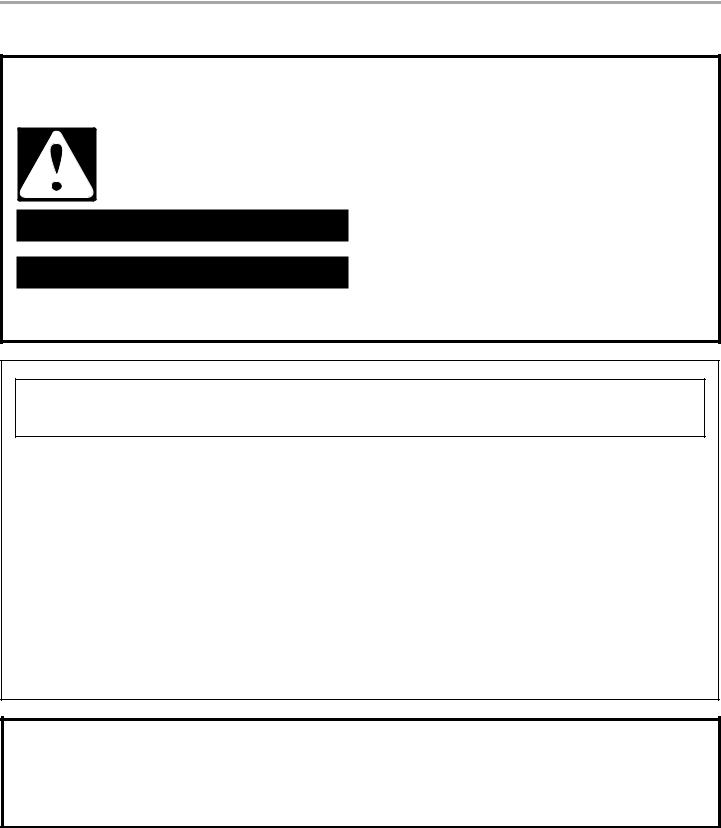
DRYER SAFETY
Your safety and the safety of others are very important.
We have provided many important safety messages in this manual and on your appliance. Always read and obey all safety messages.
This is the safety alert symbol.
This symbol alerts you to potential hazards that can kill or hurt you and others.
All safety messages will follow the safety alert symbol and either the word “DANGER” or “WARNING.” These words mean:
 DANGER
DANGER
 WARNING
WARNING
You can be killed or seriously injured if you don't immediately follow instructions.
You can be killed or seriously injured if you don't follow instructions.
All safety messages will tell you what the potential hazard is, tell you how to reduce the chance of injury, and tell you what can happen if the instructions are not followed.
WARNING: For your safety, the information in this manual must be followed to minimize the risk of fire or explosion, or to prevent property damage, personal injury, or death.
–Do not store or use gasoline or other flammable vapors and liquids in the vicinity of this or any other appliance.
–WHAT TO DO IF YOU SMELL GAS:
•Do not try to light any appliance.
•Do not touch any electrical switch; do not use any phone in your building.
•Clear the room, building, or area of all occupants.
•Immediately call your gas supplier from a neighbor's phone. Follow the gas supplier's instructions.
•If you cannot reach your gas supplier, call the fire department.
–Installation and service must be performed by a qualified installer, service agency, or the gas supplier.
In the State of Massachusetts, the following installation instructions apply:
■Installations and repairs must be performed by a qualified or licensed contractor, plumber, or gasfitter qualified or licensed by the State of Massachusetts.
■If using a ball valve, it shall be a T-handle type.
■A flexible gas connector, when used, must not exceed 3 feet.
3
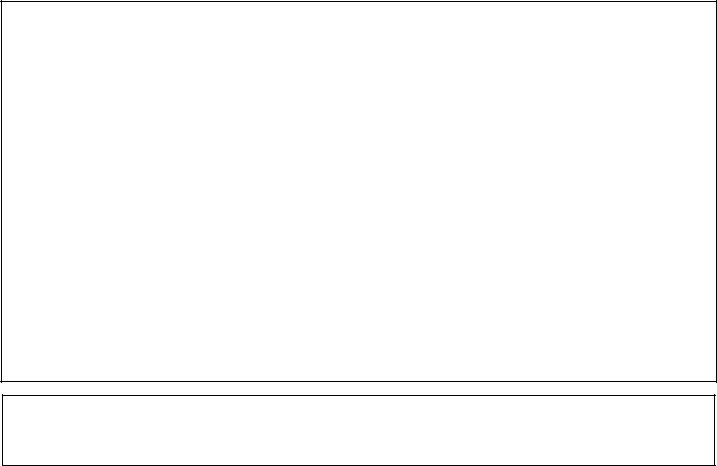
IMPORTANT SAFETY INSTRUCTIONS
WARNING: To reduce the risk of fire, electric shock, or injury to persons when using the dryer, follow basic precautions, including the following:
■Read all instructions before using the dryer.
■Do not place items exposed to cooking oils in your dryer. Items contaminated with cooking oils may contribute to a chemical reaction that could cause a load to catch fire.
■Do not dry articles that have been previously cleaned in, washed in, soaked in, or spotted with gasoline, drycleaning solvents, or other flammable or explosive substances as they give off vapors that could ignite or explode.
■Do not allow children to play on or in the dryer. Close supervision of children is necessary when the dryer is used near children.
■Before the dryer is removed from service or discarded, remove the door to the drying compartment.
■Do not reach into the dryer if the drum is moving.
■Do not install or store the dryer where it will be exposed to the weather.
■Do not tamper with controls.
■Do not repair or replace any part of the dryer or attempt any servicing unless specifically recommended in this Use and Care Guide or in published user-repair instructions that you understand and have the skills to carry out.
■Do not use fabric softeners or products to eliminate static unless recommended by the manufacturer of the fabric softener or product.
■Do not use heat to dry articles containing foam rubber or similarly textured rubber-like materials.
■Clean lint screen before or after each load.
■Keep area around the exhaust opening and adjacent surrounding areas free from the accumulation of lint, dust, and dirt.
■The interior of the dryer and exhaust vent should be cleaned periodically by qualified service personnel.
■See installation instructions for grounding requirements.
SAVE THESE INSTRUCTIONS
IMPORTANT: The gas installation must conform with local codes, or in the absence of local codes, with the National Fuel Gas Code, ANSI Z223.1/NFPA 54 or the Canadian Natural Gas and Propane Installation Code, CSA B149.1.
The dryer must be electrically grounded in accordance with local codes, or in the absence of local codes, with the National Electrical Code, ANSI/NFPA 70 or Canadian Electrical Code, CSA C22.1.
4
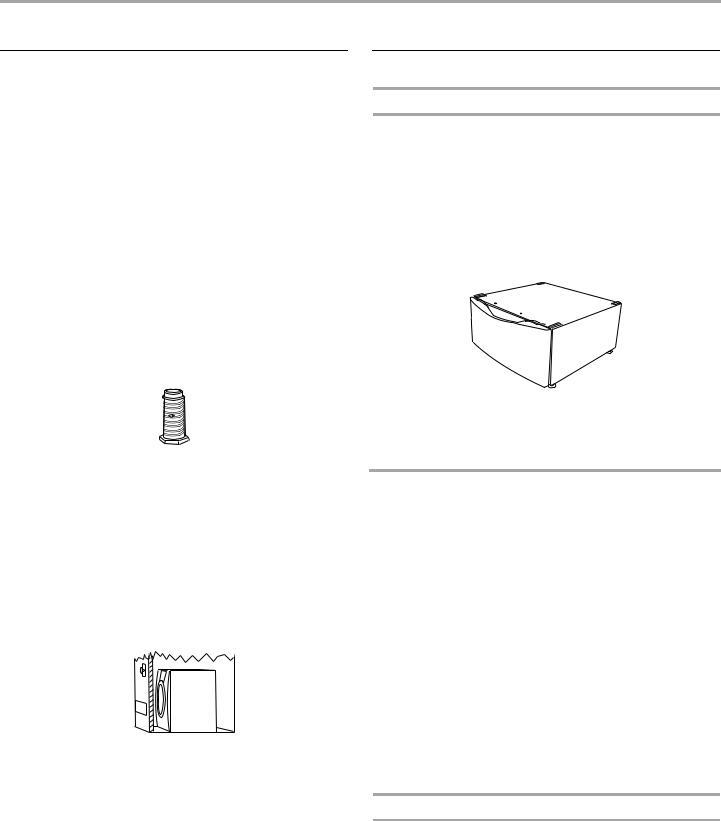
INSTALLATION INSTRUCTIONS
ToolsandParts
Gather the required tools and parts before starting installation. Read and follow the instructions provided with any tools listed here.
■8" or 10" pipe wrench
■8" or 10" adjustable wrench (for gas connections)
■Flat-blade screwdriver
■Adjustable wrench that opens to 1" (2.5 cm) or hex-head socket wrench (for adjusting dryer feet)
■¹⁄" nut driver or socket wrench
Parts supplied
■Level
■Knife
■Vent clamps
■Pipe-joint compound resistant to LP gas
■Caulking gun and compound (for installing new exhaust vent)
■Pliers
■Tape measure
Remove parts packages from dryer drum. Check that all parts are included.
■Parts package
4 Leveling legs
NOTE: Do not use leveling legs if installing the dryer on a pedestal.
Parts needed
Check local codes and with gas supplier. Check existing gas supply, electrical supply and venting. Read “Electrical Requirements,” “Gas Supply Requirements” and “Venting Requirements” before purchasing parts.
■For close-clearance installations between 31.5" (80.01 cm) and 37" (93.98 cm), see “Plan Vent System” section for venting requirements.

 37"
37" 
 (93.98 cm)
(93.98 cm)
Mobile home installations require special parts (listed following) that may be ordered by calling the dealer from whom you purchased your dryer. For further information, please refer to the “Assistance or Service” section of this manual.
■Mobile Home Installation Kit. Ask for Part Number 346764.
■Metal exhaust system hardware.
Options
Pedestal
Are you placing the dryer on a pedestal? You have the option of purchasing pedestals of different heights separately for this dryer. You may select a 10" (25.4 cm), a 13" (33 cm) or a 15.5" (39.4 cm) pedestal. These pedestals will add to the total height of the dryer for a total height of approximately 48" (121.9 cm), 51" (129.5 cm) or 53.5" (135.9 cm), respectively.
For a garage installation, you will need to place the 10" (25.4 cm) pedestal at least 9" (22.9 cm) above the floor and the 13" (33 cm) pedestal at least 6" (15.2 cm) above the floor. You will need to place the 15.5" (39.4 cm) pedestal at least 3.5" (8.9 cm) above the floor.
Optional pedestal
The pedestals are available in several colors.
To order, call the dealer from whom you purchased your dryer or refer to the “Assistance or Service” section of this manual.
Pedestal |
Color |
Part Number |
Height |
|
|
|
|
|
10" (25.4 cm) |
White |
WHP1000SQ |
|
|
|
10" (25.4 cm) |
Biscuit |
WHP1000ST |
|
|
|
10" (25.4 cm) |
Pewter |
WHP1000SL |
|
|
|
10" (25.4 cm) |
Diamond Dust |
WHP1000SU |
|
(Silver) |
|
|
|
|
13" (33 cm) |
White |
LAB2700MQ |
|
|
|
13" (33 cm) |
Biscuit |
LAB2700MT |
|
|
|
13" (33 cm) |
Pewter |
LAB2700ML |
|
|
|
15.5" (39.4 cm) |
White |
WHP1500SQ |
|
|
|
15.5" (39.4 cm) |
Biscuit |
WHP1500ST |
|
|
|
15.5" (39.4 cm) |
Pewter |
WHP1500SL |
|
|
|
15.5" (39.4 cm) |
Diamond Dust |
WHP1500SU |
|
(Silver) |
|
Stack Kit
Are you planning to stack your DUET® washer and dryer? To do so, you will need to purchase a Stack Kit.
To order, call the dealer from whom you purchased your dryer or refer to the “Assistance or Service” section of this manual. Ask for Part Number 8541503.
5
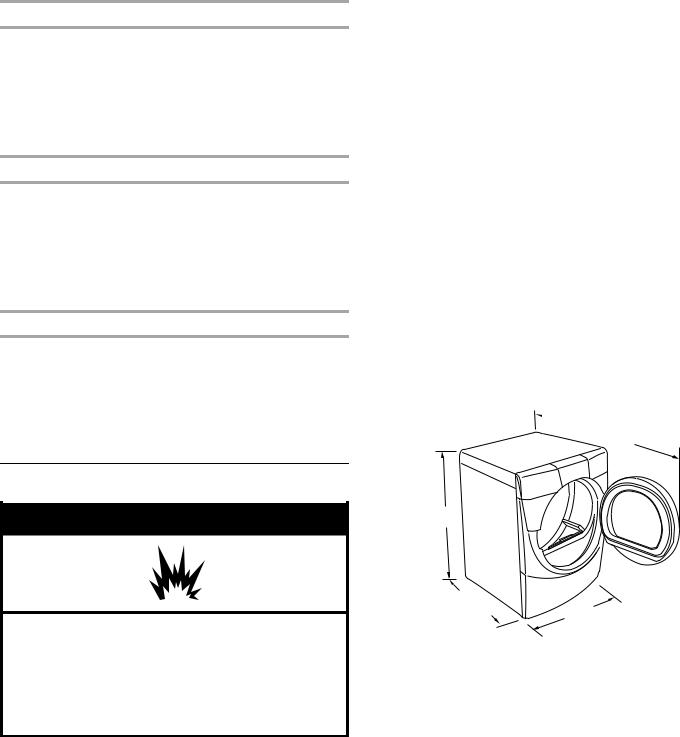
Door Reversal Kit
Are you planning to reverse the door swing direction on your DUET® dryer? To do so, you will need to purchase a Door Reversal Kit.
To order, call the dealer from whom you purchased your dryer or refer to the “Assistance or Service” section of this manual. Ask for Part Number 8530069 (Shield Blue), 8530070 (Shield Platinum), 8530071 (Biscuit), 8530072 (Pewter) or 8579123 (Diamond Dust [Silver]).
Door Reversal and Stack Combination Kit
Are you planning to reverse the door swing direction on your DUET® dryer and stack your DUET® washer and dryer? To do so, you can purchase a Door Reversal and Stack Combination Kit.
To order, call the dealer from whom you purchased your dryer or refer to the “Assistance or Service” section of this manual. Ask for Part Number 8530073 (Shield Blue), 8530074 (Shield Platinum), 8530075 (Biscuit), 8530076 (Pewter) or W10057200 (Diamond Dust [Silver]).
Backguard
If you are installing your DUET® washer and dryer and wish to avoid having loose items fall behind your machines, you may purchase a pair of washer/dryer backguards. These will reduce the chance of items falling behind the machines during operation.
To order, call the dealer from whom you purchased your dryer or refer to the “Assistance or Service” section of this manual. Ask for Part Number 8558694 (White), 8558695 (Biscuit), 8558696 (Pewter), or W10057220 (Diamond Dust [Silver]).
LocationRequirements
 WARNING
WARNING
Explosion Hazard
Keep flammable materials and vapors, such as gasoline, away from dryer.
Place dryer at least 18 inches (46 cm) above the floor for a garage installation.
Failure to do so can result in death, explosion, or fire.
You will need
■A location that allows for proper exhaust installation. A gas dryer must be exhausted to the outdoors. See “Venting Requirements.”
■A grounded electrical outlet located within 2 ft (61 cm) of either side of the dryer. See “Electrical Requirements.”
■A sturdy floor to support the total dryer weight of 200 lbs (90.7 kg). The combined weight of a companion appliance should also be considered.
■A level floor with a maximum slope of 1" (2.5 cm) under entire dryer. If slope is greater than 1" (2.5 cm), install Extended Dryer Feet Kit, Part Number 279810. Clothes may not tumble properly, and automatic sensor cycles may not operate correctly if dryer is not level.
■For a garage installation, you will need to place the dryer at least 18" (46 cm) above the floor. If you are using a 10" (25.4 cm) pedestal, you will need to place the pedestal at least 9" (22.9 cm) above the floor. With a 13" (33 cm) pedestal, you will need to place the pedestal at least
6" (15.2 cm) above the floor. With a 15.5" (39.4 cm) pedestal, you will need to place the pedestal at least 3.5" (8.9 cm) above the floor.
Do not operate your dryer at temperatures below 45ºF (7ºC). At lower temperatures, the dryer might not shut off at the end of an automatic cycle. This can result in longer drying times.
The dryer must not be installed or stored in an area where it will be exposed to water and/or weather.
Check code requirements. Some codes limit, or do not permit, installation of the dryer in garages, closets, mobile homes or sleeping quarters. Contact your local building inspector.
NOTE: No other fuel-burning appliance can be installed in the same closet as a dryer.
Installation clearances
The location must be large enough to allow the dryer door to open fully.
Dryer Dimensions
 51½" (130.81 cm)
51½" (130.81 cm)
38" (96.52 cm)
*31½"
(80 cm) 27"
(68.6 cm)
*Most installations require a minimum 5" (12.7 cm) clearance behind the dryer for the exhaust vent with elbow. See “Venting Requirements.”
Installation spacing for recessed area or closet installation
The following spacing dimensions are recommended for this dryer. This dryer has been tested for spacing of 0" (0 cm) clearance on the sides and rear. Recommended spacing should be considered for the following reasons:
■Additional spacing should be considered for ease of installation and servicing.
■Additional clearances might be required for wall, door and floor moldings.
■Additional spacing should be considered on all sides of the dryer to reduce noise transfer.
■For closet installation, with a door, minimum ventilation openings in the top and bottom of the door are required. Louvered doors with equivalent ventilation openings are acceptable.
■Companion appliance spacing should also be considered.
6
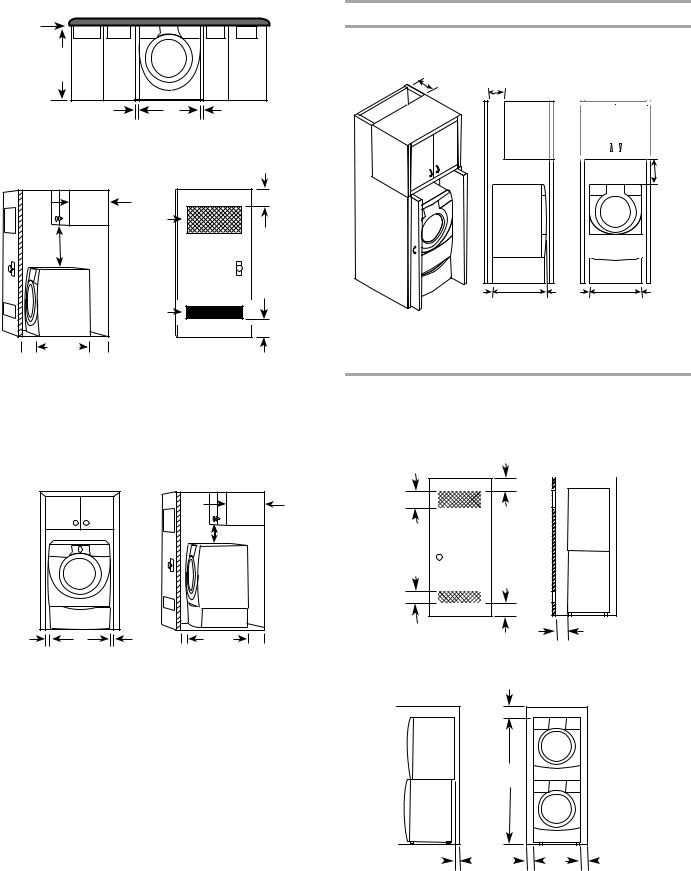
Custom undercounter installation - Dryer only
0" |
|
Installation spacing for cabinet installation |
|
|
|
(0 cm) |
|
■ For cabinet installation, with a door, minimum ventilation |
|
|
|
38" min. |
|
openings in the top of the cabinet are required. |
(96.52 cm) |
|
7"* (17.8 cm) 7"* (17.8 cm) |
|
|
|
1"* |
27" |
1"* |
(2.5 cm) |
(68.6 cm) |
(2.5 cm) |
*Required spacing |
|
|
Closet installation - Dryer only |
|
9"* |
|
|
|
|
|
(22.9 cm) |
|
|
|
|
3"* |
|
|
|
|
|
|
14" max.* |
|
(7.6 cm) |
|
|
|
|
|
|
|
48 in.2* |
|
|
|
|
|
|
||
|
(35.6 cm) |
|
|
|
|
|
|
||
|
|
|
(310 cm2) |
|
|
|
|
|
|
|
18" min.* |
|
|
|
|
|
|
|
|
|
(45.72 cm) |
|
|
|
|
|
|
|
|
|
|
|
24 in.2* |
5"** |
31¹" |
1"* |
1" |
27" |
1" |
|
|
|
(155 cm2) |
(12.7 cm) |
(80.0 cm) (2.5 cm) (2.5 cm)(68.6 cm) (2.5 cm) |
||||
|
|
|
|
3"* |
|
|
|
|
|
|
|
|
|
(7.6 cm) |
|
|
|
|
|
1"* |
31½" |
5"** |
|
*Required spacing |
|
|
|
|
|
|
**For side or bottom venting, 0" (0 cm) spacing is allowed. |
||||||||
(2.5 cm) |
(80 cm) (12.7 cm) |
|
|||||||
|
A |
|
|
B |
|
|
|
|
|
|
Recommended installation spacing for recessed or |
|||
A. Side view - closet or confined area |
closet installation, with stacked washer and dryer |
|||
B. Closet door with vents |
|
|
|
|
The dimensions shown are for the recommended spacing. |
||||
*Required spacing |
||||
|
|
|
||
**For side or bottom venting, 0" (0 cm) spacing is allowed. |
48 in.2 * |
|||
Recessed or closet installation - Dryer on pedestal |
(310 cm2) |
|||
|
|
|
||
3"* (7.6 cm)
|
|
|
|
|
14" max.* |
|
|
|
|
|
|
|
(35.6 cm) |
|
|
|
|
|
|
18" min.* |
|
|
|
|
|
|
|
(45.72 cm) |
|
|
|
|
|
|
|
|
|
|
3"* (7.6 cm) |
|
|
|
|
|
|
24 in.2 * |
1"* (2.5 cm) |
1" |
27" |
1" |
1"* |
31½" |
5"** |
(155 cm2) |
|
(2.5 cm) |
(68.6 cm) |
(2.5 cm) |
(2.5 cm) |
(80 cm) |
(12.7 cm) |
*Required spacing |
|
|
A |
|
|
B |
|
|
|
|
|
|
|
|
|
||
A. Recessed area |
6"* (15.2 cm) |
B. Side view - closet or confined area
*Required spacing
**For side or bottom venting, 0" (0 cm) spacing is allowed.
76" (193 cm)
5"* |
|
|
|
1" |
|
|
|
27" |
|
1" |
|
|
|
|
|
||||||
(12.7 cm) |
|
|
(2.5 cm) |
|
|
(68.6 cm) |
(2.5 cm) |
|||
*Required spacing
7
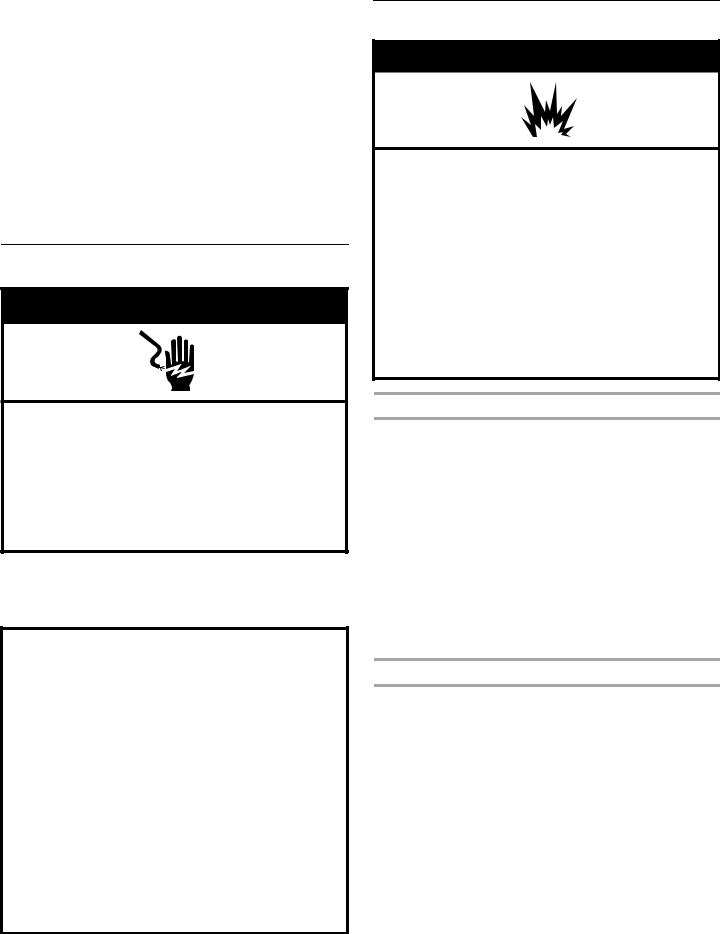
Mobile home - Additional installation requirements
This dryer is suitable for mobile home installations. The installation must conform to the Manufactured Home Construction and Safety Standard, Title 24 CFR, Part 3280 (formerly the Federal Standard for Mobile Home Construction and Safety, Title 24, HUD Part 280) or Standard CAN/CSA-Z240 MH.
Mobile home installations require:
■Metal exhaust system hardware, which is available for purchase from your dealer.
■Mobile Home Installation Kit Part Number 346764. See “Tools and Parts” section for ordering information.
■Special provisions must be made in mobile homes to introduce outside air into the dryer. The opening (such as a nearby window) should be at least twice as large as the dryer exhaust opening.
ElectricalRequirements
 WARNING
WARNING
Electrical Shock Hazard
Plug into a grounded 3 prong outlet.
Do not remove ground prong.
Do not use an adapter.
Do not use an extension cord.
Failure to follow these instructions can result in death, fire, or electrical shock.
■120 Volt, 60 Hz., AC only, 15or 20-amp fused electrical supply is required. A time-delay fuse or circuit breaker is recommended. It is also recommended that a separate circuit serving only this dryer be provided.
GROUNDING INSTRUCTIONS
■ For a grounded, cord-connected dryer:
This dryer must be grounded. In the event of malfunction or breakdown, grounding will reduce the risk of electric shock by providing a path of least resistance for electric current.
This dryer is equipped with a cord having an equipmentgrounding conductor and a grounding plug. The plug must be plugged into an appropriate outlet that is properly installed and grounded in accordance with all local codes and ordinances.
WARNING: Improper connection of the equipmentgrounding conductor can result in a risk of electric shock. Check with a qualified electrician or service representative or personnel if you are in doubt as to whether the dryer is properly grounded. Do not modify the plug provided with the dryer: if it will not fit the outlet, have a proper outlet installed by a qualified electrician.
SAVE THESE INSTRUCTIONS
GasSupplyRequirements
 WARNING
WARNING
Explosion Hazard
Use a new CSA International approved gas supply line.
Install a shut-off valve.
Securely tighten all gas connections.
If connected to LP, have a qualified person make sure gas pressure does not exceed 13" (33 cm) water column.
Examples of a qualified person include:
licensed heating personnel,
authorized gas company personnel, and authorized service personnel.
Failure to do so can result in death, explosion, or fire.
Gas Type
Natural gas:
This dryer is equipped for use with Natural gas. It is designcertified by CSA International for LP (propane or butane) gases with appropriate conversion.
■Your dryer must have the correct burner for the type of gas in your home. Burner information is located on the rating plate in the door well of your dryer. If this information does not agree with the type of gas available, contact your dealer or call the phone numbers referenced in the “Assistance or Service” section of this manual.
LP gas conversion:
Conversion must be made by a qualified technician.
No attempt shall be made to convert the appliance from the gas specified on the model/serial rating plate for use with a different gas without consulting your gas company.
Gas supply line
■Must include ¹⁄ " NPT minimum plugged tapping accessible for test gauge connection, immediately upstream of the gas connection to the dryer (see illustration).
■¹⁄ " IPS pipe is recommended.
■³⁄ " approved aluminum or copper tubing is acceptable for lengths under 20 ft (6.1 m) if local codes and gas supplier permit.
■If you are using Natural gas, do not use copper tubing.
■Lengths over 20 ft (6.1 m) should use larger tubing and a different size adapter fitting.
8
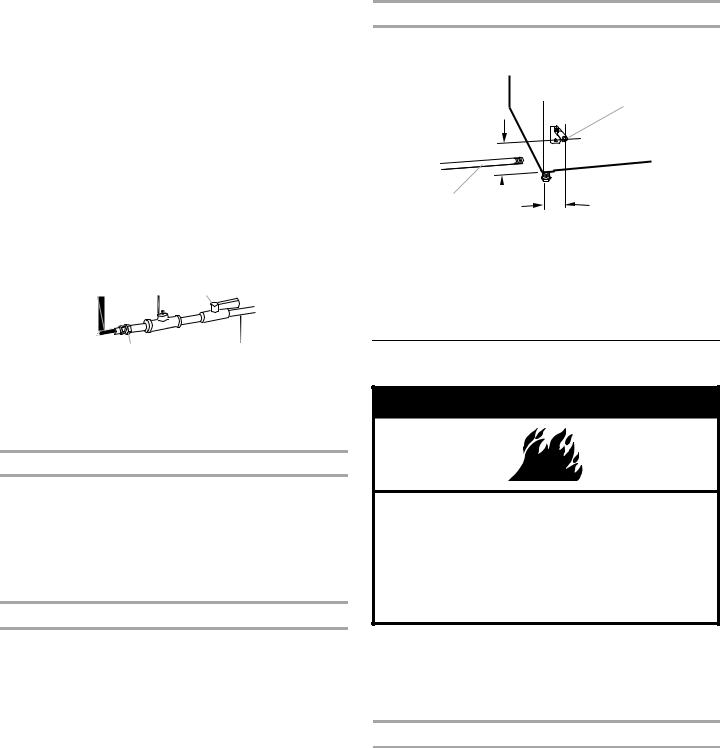
■If your dryer has been converted to use LP gas, ³⁄ " LP compatible copper tubing can be used. If the total length of the supply line is more than 20 ft (6.1 m), use larger pipe.
NOTE: Pipe-joint compounds that resist the action of LP gas must be used. Do not use TEFLON®† tape.
■Must include a shutoff valve:
In the U.S.A.:
An individual manual shutoff valve must be installed within six (6) feet (1.8 m) of the dryer in accordance with the National Fuel Gas Code, ANSI Z223.1.
In Canada:
An individual manual shutoff valve must be installed in accordance with the B149.1, Natural Gas and Propane Installation Code. It is recommended that an individual manual shutoff valve be installed within six (6) feet (1.8 m) of the dryer.
The location should be easy to reach for opening and closing.
A C E
B D
A.³⁄ " flexible gas connector
B.³⁄ " pipe to flare adapter fitting
C.¹⁄ " NPT minimum plugged tapping
D.½" NPT gas supply line
E.Gas shutoff valve
Gas supply connection requirements
■Use an elbow and a ³⁄ " flare x ³⁄ " NPT adapter fitting between the flexible gas connector and the dryer gas pipe, as needed to avoid kinking.
■Use only pipe-joint compound. Do not use TEFLON®† tape.
■This dryer must be connected to the gas supply line with a listed flexible gas connector that complies with the standard for connectors for gas appliances, ANSI Z21.24 or CSA 6.10.
Burner input requirements
Elevations above 10,000 ft (3,048 m):
■When installed above 10,000 ft (3,048 m) a 4% reduction of the burner Btu rating shown on the model/serial number plate is required for each 1,000 ft (305 m) increase in elevation.
Gas supply pressure testing
■The dryer must be disconnected from the gas supply piping system during pressure testing at pressures greater than
½ psi.
†®TEFLON is a registered trademark of E.I. Du Pont De Nemours and Company.
Dryer gas pipe
■The gas pipe that comes out through the rear of your dryer has a ³⁄ " male pipe thread.
B
*6¼"
(15.9 cm)
A |
|
1½" |
|
||
|
(3.8 cm) |
A. ½" NPT gas supply line
B. ³⁄" NPT dryer pipe
*NOTE: If the dryer is mounted on a pedestal, the gas pipe height must be an additional 10" (25.4 cm), 13" (33 cm) or 15.5"
(39.4 cm) from the floor, depending on the pedestal model. For a garage installation, the gas pipe height must be an additional 18" (46 cm) from the floor.
VentingRequirements
 WARNING
WARNING
Fire Hazard
Use a heavy metal vent.
Do not use a plastic vent.
Do not use a metal foil vent.
Failure to follow these instructions can result in death or fire.
WARNING: To reduce the risk of fire, this dryer MUST BE EXHAUSTED OUTDOORS.
IMPORTANT: Observe all governing codes and ordinances.
The dryer exhaust must not be connected into any gas vent, chimney, wall, ceiling or a concealed space of a building.
If using an existing vent system
■Clean lint from the entire length of the system and make sure exhaust hood is not plugged with lint.
■Replace any plastic or metal foil vent with rigid or flexible heavy metal vent.
■Review Vent system chart. Modify existing vent system if necessary to achieve the best drying performance.
9
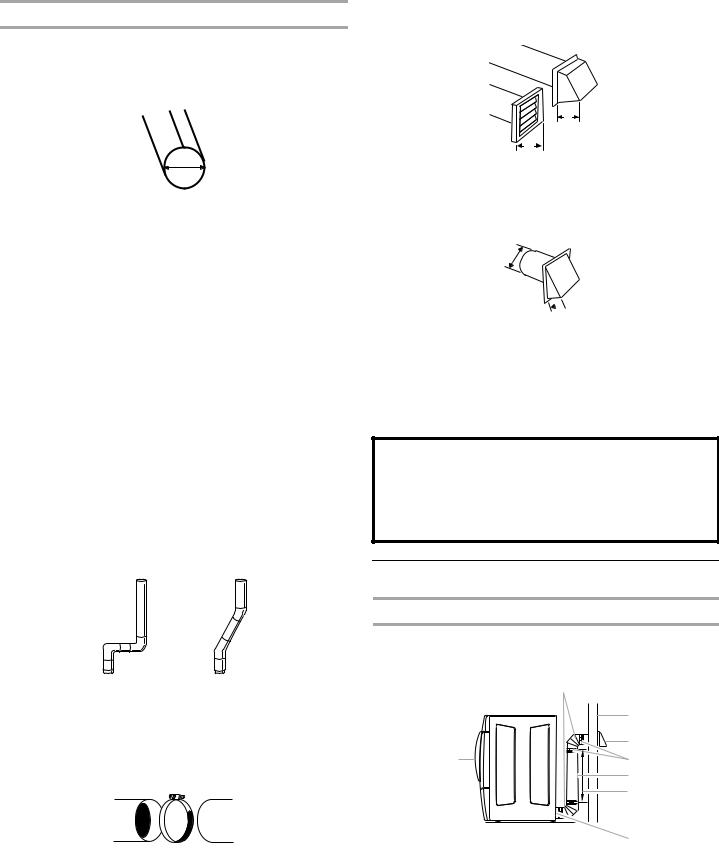
If this is a new vent system
Vent material
■Use a heavy metal vent. Do not use plastic or metal foil vent.
■4" (10.2 cm) heavy metal exhaust vent and clamps must be used. DURASAFE™ venting products are recommended.
4"
10.2 cm
4" (10.2 cm) heavy metal exhaust vent
DURASAFE™ vent products can be purchased from your dealer or by calling Whirlpool Parts and Accessories. For more information, see the “Assistance or Service” section of this manual.
Rigid metal vent
■For best drying performance, rigid metal vents are recommended.
■Rigid metal vent is recommended to avoid crushing and kinking.
Flexible metal vent
■Flexible metal vents are acceptable only if accessible for cleaning.
■Flexible metal vent must be fully extended and supported when the dryer is in its final location.
■Remove excess flexible metal vent to avoid sagging and kinking that may result in reduced airflow and poor performance.
■Do not install flexible metal vent in enclosed walls, ceilings or floors.
Elbows
45° elbows provide better airflow than 90° elbows.
Good |
Better |
Clamps
■Use clamps to seal all joints.
■Exhaust vent must not be connected or secured with screws or other fastening devices that extend into the interior of the duct. Do not use duct tape.
Clamp
Exhaust
Recommended hood styles are shown here.
B
A
4" (10.2 cm)
4" (10.2 cm)
A.Louvered hood style
B.Box hood style
The angled hood style (shown here) is acceptable.
4" (10.2 cm)
 2½" (6.4 cm)
2½" (6.4 cm)
■An exhaust hood should cap the vent to keep rodents and insects from entering the home.
■Exhaust hood must be at least 12" (30.5 cm) from the ground or any object that may be in the path of the exhaust (such as flowers, rocks or bushes, snow line, etc.).
■Do not use an exhaust hood with a magnetic latch.
Improper venting can cause moisture and lint to collect indoors, which may result in:
 Moisture damage to woodwork, furniture, paint, wallpaper, carpets, etc.
Moisture damage to woodwork, furniture, paint, wallpaper, carpets, etc.
 Housecleaning problems and health problems.
Housecleaning problems and health problems.
PlanVentSystem
Choose your exhaust installation type
Recommended exhaust installations
Typical installations vent the dryer from the rear of the dryer. Other installations are possible.
|
B |
|
C |
|
D |
A |
E |
|
F |
|
G |
|
H |
A. Dryer |
E. Clamps |
B. Elbow |
F. Rigid metal or flexible metal vent |
C. Wall |
G. Vent length necessary to connect elbows |
D. Exhaust hood |
H. Exhaust outlet |
10

Optional exhaust installations
This dryer can be converted to exhaust out the right side, left side, or through the bottom. Contact your local dealer to have the dryer converted.
 WARNING
WARNING
Fire Hazard
Cover unused exhaust holes with one of the following kits:
279818 (white)
279925 (biscuit)
279969 (pewter)
280171 (diamond dust)
Contact your local dealer.
Failure to follow these instructions can result in death, fire, electrical shock, or serious injury.
A B C
A.Standard rear offset exhaust installation
B.Left or right side exhaust installation
C.Bottom exhaust installation (not an option with pedestal installations)
Alternate installations for close clearances
Venting systems come in many varieties. Select the type best for your installation. Two close-clearance installations are shown. Refer to the manufacturer’s instructions.
A B
A.Over-the-top installation (also available with one offset elbow)
B.Periscope installation
NOTE: The following kits for close clearance alternate installations are available for purchase. Please see the “Assistance or Service” section of this manual to order.
■Over-the-Top Installation: Part Number 4396028
■Periscope Installation (For use with dryer vent to wall vent mismatch):
Part Number 4396037 - 0" (0 cm) to 18" (45.72 cm) mismatch
Part Number 4396011 - 18" (45.72 cm) to 29" (73.66 cm) mismatch
Part Number 4396014 - 29" (73.66 cm) to 50" (127 cm) mismatch
Special provisions for mobile home installations
The exhaust vent must be securely fastened to a noncombustible portion of the mobile home structure and must not terminate beneath the mobile home. Terminate the exhaust vent outside.
Determine vent path
■Select the route that will provide the straightest and most direct path outdoors.
■Plan the installation to use the fewest number of elbows and turns.
■When using elbows or making turns, allow as much room as possible.
■Bend vent gradually to avoid kinking.
■Use the fewest 90° turns possible.
Determine vent length and elbows needed for best drying performance
■Use the following Vent system chart to determine type of vent material and hood combinations acceptable to use.
NOTE: Do not use vent runs longer than those specified in the Vent system chart. Exhaust systems longer than those specified will:
■Shorten the life of the dryer.
■Reduce performance, resulting in longer drying times and increased energy usage.
The Vent system chart provides venting requirements that will help to achieve the best drying performance.
11
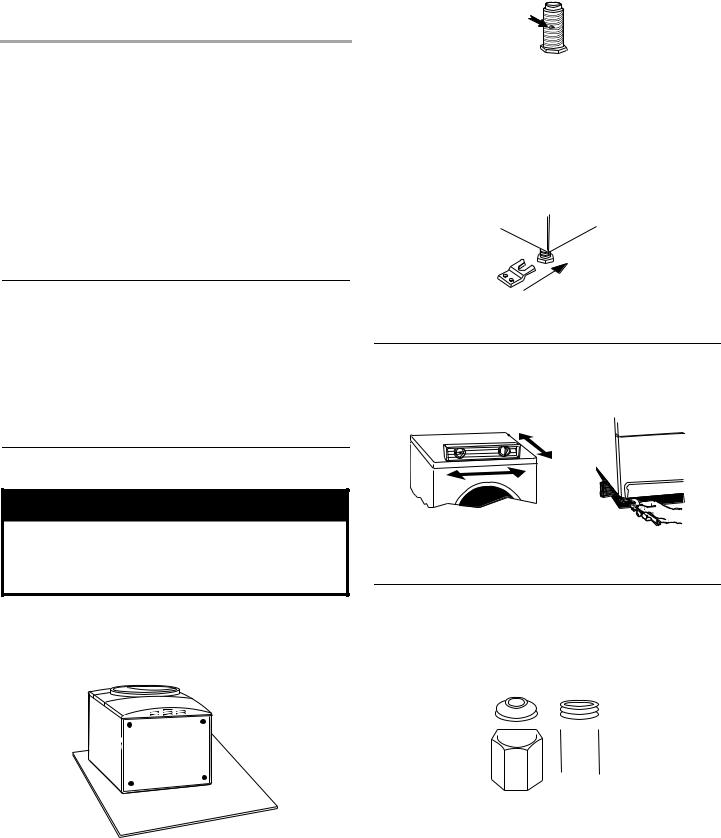
Vent system chart
NOTE: Side and bottom exhaust installations have a 90º turn inside the dryer. To determine maximum exhaust length, add one 90º turn to the chart.
Number of |
Type of |
Box or |
Angled |
90º turns |
vent |
louvered |
hoods |
or elbows |
|
hoods |
|
|
|
|
|
0 |
Rigid metal |
64 ft (20 m) |
58 ft (17.7 m) |
|
Flexible metal |
36 ft (11 m) |
28 ft (8.5 m) |
|
|
|
|
1 |
Rigid metal |
54 ft (16.5 m) |
48 ft (14.6 m) |
|
Flexible metal |
31 ft (9.4 m) |
23 ft (7 m) |
|
|
|
|
2 |
Rigid metal |
44 ft (13.4 m) |
38 ft (11.6 m) |
|
Flexible metal |
27 ft (8.2 m) |
19 ft (5.8 m) |
|
|
|
|
3 |
Rigid metal |
35 ft (10.7 m) |
29 ft (8.8 m) |
|
Flexible metal |
25 ft (7.6 m) |
17 ft (5.2 m) |
|
|
|
|
4 |
Rigid metal |
27 ft (8.2 m) |
21 ft (6.4 m) |
|
Flexible metal |
23 ft (7 m) |
15 ft (4.6 m) |
3.Examine the leveling legs. Find the diamond marking.
4.Screw the legs into the leg holes by hand. Use a wrench to finish turning the legs until the diamond marking is no longer visible.
5.Place a carton corner post from dryer packaging under each of the 2 dryer back corners. Stand the dryer up. Slide the dryer on the corner posts until it is close to its final location. Leave enough room to connect the exhaust vent or gas line.
For mobile home use
Gas dryers must be securely fastened to the floor at the time of installation.
InstallVentSystem
1.Install exhaust hood. Use caulking compound to seal exterior wall opening around exhaust hood.
2.Connect vent to exhaust hood. Vent must fit inside exhaust hood. Secure vent to exhaust hood with 4" (10.2 cm) clamp.
3.Run vent to dryer location. Use the straightest path possible. See “Determine vent path” in “Plan Vent System.” Avoid 90º turns. Use clamps to seal all joints. Do not use duct tape, screws or other fastening devices that extend into the interior of the vent to secure vent.
InstallLevelingLegs
 WARNING
WARNING
Excessive Weight Hazard
Use two or more people to move and install dryer. Failure to do so can result in back or other injury.
1.To protect the floor, use a large flat piece of cardboard from the dryer carton. Place cardboard under the entire back edge of the dryer.
2.Firmly grasp the body of the dryer. Gently lay the dryer on the cardboard. See illustration.
Mobile home installations require a Mobile Home Installation Kit. For more information, please reference the service numbers in the “Assistance or Service” section of this manual.
LevelDryer
Check the levelness of the dryer. Check levelness first side to side, then front to back.
If the dryer is not level, prop up the dryer using a wood block. Use a wrench to adjust the legs up or down and check again for levelness.
MakeGasConnection
1.Remove the red cap from the gas pipe.
2.Using a wrench to tighten, connect the gas supply to the dryer. Use pipe-joint compound on the threads of all nonflared male fittings. If flexible metal tubing is used, be sure there are no kinks.
A 

 B
B
A.Flared male fitting
B.Non-flared male fitting
NOTE: For LP gas connections, you must use pipe-joint compound resistant to the action of LP gas. Do not use TEFLON®† tape.
†®TEFLON is a registered trademark of E.I. Du Pont De Nemours and Company.
12
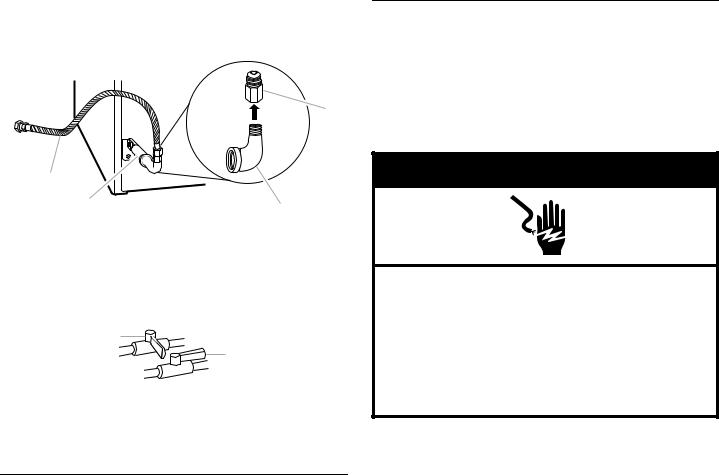
A combination of pipe fittings must be used to connect the dryer to the existing gas line. Shown is a recommended connection. Your connection may be different, according to the supply line type, size and location.
D
A
B
C
A.³⁄ " flexible gas connector
B.³⁄ " dryer pipe
C.³⁄ " to ³⁄ " pipe elbow
D.³⁄ " pipe-to-flare adapter fitting
3.Open the shutoff valve in the supply line. The valve is open when the handle is parallel to the gas pipe.
A
B
A.Closed valve
B.Open valve
4.Test all connections by brushing on an approved noncorrosive leak-detection solution. Bubbles will show a leak. Correct any leak found.
ConnectVent
1.Using a 4" (10.2 cm) clamp, connect vent to exhaust outlet in dryer. If connecting to existing vent, make sure the vent is clean. The dryer vent must fit over the dryer exhaust outlet and inside the exhaust hood. Make sure the vent is secured to exhaust hood with a 4" (10.2 cm) clamp.
2.Move dryer into its final location. Do not crush or kink vent.
3.(On gas models) Check that there are no kinks in the flexible gas line.
4.Once the exhaust vent connection is made, remove the corner posts and cardboard.
CompleteInstallation
1.Check that all parts are now installed. If there is an extra part, go back through the steps to see which step was skipped.
2.Check that you have all of your tools.
3.Dispose of/recycle all packaging materials.
4.Check the dryer’s final location. Be sure the vent is not crushed or kinked.
5.Check that the dryer is level. See “Level Dryer.”
 WARNING
WARNING
Electrical Shock Hazard
Plug into a grounded 3 prong outlet.
Do not remove ground prong.
Do not use an adapter.
Do not use an extension cord.
Failure to follow these instructions can result in death, fire, or electrical shock.
6.Plug into a grounded 3 prong outlet. Turn on power.
7.Remove any protective film or tape remaining on the dryer.
8.Read “Dryer Use.”
9.Wipe the dryer drum interior thoroughly with a damp cloth to remove any dust.
10.Select a Timed Dry heated cycle, and start the dryer. Do not select the Air Only Temperature setting.
If the dryer will not start, check the following:
■Dryer is plugged into a grounded 3 prong outlet.
■Electrical supply is connected.
■Household fuse is intact and tight, or circuit breaker has not tripped.
■Dryer door is closed.
11.When the dryer has been running for 5 minutes, open the dryer door and feel for heat. If you feel heat, cancel cycle and close door. If you do not feel heat, turn off the dryer and check that the gas supply line shutoff valve is open.
■If the gas supply line shutoff valve is closed, open it, then repeat the 5-minute test as outlined above.
■If the gas supply line shutoff valve is open, contact a qualified technician.
13
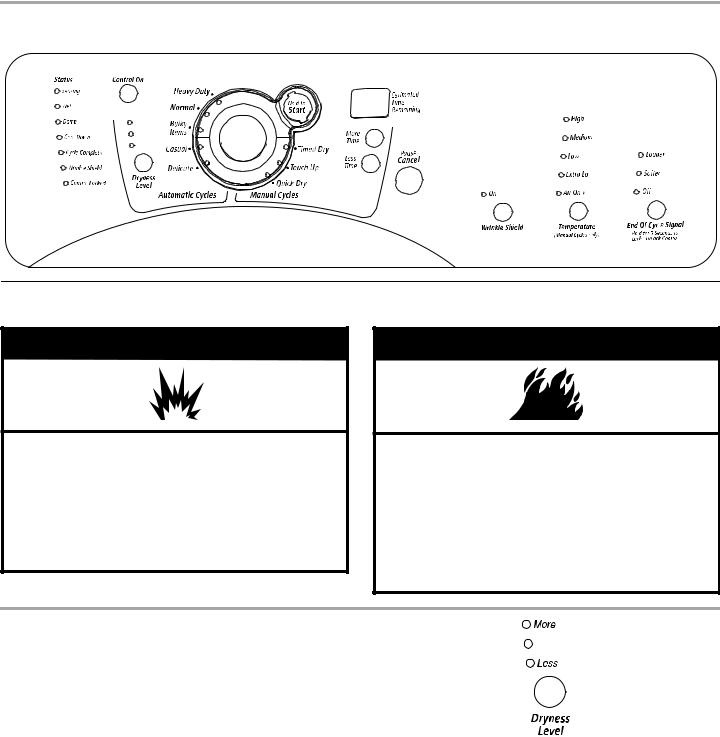
DRYER USE
More
Less
StartingYourDryer
 WARNING
WARNING
Explosion Hazard
Keep flammable materials and vapors, such as gasoline, away from dryer.
Do not dry anything that has ever had anything flammable on it (even after washing).
Failure to follow these instructions can result in death, explosion, or fire.
 WARNING
WARNING
Fire Hazard
No washer can completely remove oil.
Do not dry anything that has ever had any type of oil on it (including cooking oils).
Items containing foam, rubber, or plastic must be dried on a clothesline or by using an Air Cycle.
Failure to follow these instructions can result in death or fire.
The following is a guide to starting your dryer. Please refer to specific sections of this manual for more detailed information.
1.Clean lint screen before each load. See “Cleaning the Lint Screen.”
2.Place laundry into dryer and shut door.
3.Rotate the dial to select either an Automatic or Manual Cycle then press the CONTROL ON button. The preset settings and drying time for the cycle chosen will be displayed.
To use an Automatic Cycle
■Point the dial to an Automatic Cycle.
■Select DRYNESS LEVEL to adjust how dry you want the load to be. The time displayed is an estimated length of the cycle based on the Dryness Level selected. As the cycle runs, the control senses the dryness of the load and adjusts the time automatically for the selected Dryness Level.
NOTE: Time is not adjustable for Automatic Cycles. Pressing the More Time or Less Time buttons will cause a triple beep, indicating that the time cannot be changed.
■Press the WRINKLE SHIELD™ feature button if this option is desired.
■Press the END OF CYCLE SIGNAL button to set signal volume to desired level.
■Press (and hold) HOLD TO START button until dryer starts (about 1 second).
Once an Automatic cycle has started, the WRINKLE SHIELD™ feature and cycle signals can be adjusted. Press the PAUSE/CANCEL key twice to stop the dryer and clear the settings, allowing you to select another cycle and Dryness Level.
14

How Automatic Cycles Work
EvenHeat™ improves drying performance with Auto Moisture Sensing Plus, which advances the cycle as moisture is extracted from clothing. A thermistor (electronic temperature sensor) and moisture sensing strips in the dryer drum help measure the amount of moisture in the clothes as they pass. An electronic control determines the load type to help save time, avoid overdrying, and increase the accuracy of the end dryness level. After the first 5 minutes of an automatic cycle, the estimated time display will adjust based on the approximate load size, cycle, dryness level selected and amount of moisture left in the clothes. When the clothes have reached approximately 80% of the dryness level selected, the estimated time display will adjust again, showing the final drying time. Auto Moisture Sensing Plus takes the guesswork out of drying time and enhances fabric care.
To use a Manual Cycle
■Rotate the dial to select a Manual Cycle.
Press MORE TIME or LESS TIME until the desired drying time is displayed. Tap MORE TIME or LESS TIME, and the time will change by 1-minute intervals. Press and hold MORE TIME or LESS TIME, and the time will change by 5-minute intervals.
The initial time displayed is the actual drying time.
NOTE: The More Time or Less Time feature can be used only with Manual Cycles.
■Press TEMPERATURE until the desired temperature glows.
NOTE: Pressing the Dryness Level button will cause the triple beep indicating that this option is not selectable. Also, a Dryness Level is not indicated.
■Press the WRINKLE SHIELD™ feature button if this option is desired.
■Press the END OF CYCLE SIGNAL button to set volume to desired level.
■Press (and hold) HOLD TO START button until dryer starts (about 1 second).
While a Manual Cycle is running, you can change the settings for Time, Temperature, the WRINKLE SHIELD™ feature and the cycle signals. Press the PAUSE/CANCEL key twice to stop the dryer and clear the settings, allowing you to select another cycle.
StoppingYourDryer
To stop your dryer at any time
Press PAUSE/CANCEL twice or open the door.
PausingorRestarting
To pause the dryer at any time
Open the door or press PAUSE/CANCEL once.
To restart the dryer
Close the door and press (and hold) HOLD TO START button until dryer starts.
NOTE: Drying will continue from where the cycle was interrupted, if you close the door and press Start within 5 minutes. If the cycle is interrupted for more than 5 minutes, the dryer will shut off.
Select new cycle settings before restarting the dryer.
ControlLocked
This feature allows you to lock your settings to avert unintended use of the dryer. You can also use the Control Locked feature to avert unintended cycle or option changes during dryer operation.
To enable the Control Locked feature when dryer is running:
Press and hold the END OF CYCLE SIGNAL button for
3 seconds. The control is locked when a single beep is heard and the Control Locked status light is on.
■When the dryer is off, it is not necessary to press the Control On button before activating the Control Locked feature.
To unlock:
Press and hold the END OF CYCLE SIGNAL button for 3 seconds to turn this feature off.
NOTE: When the dryer is running and Control Locked is on, the dryer can be stopped by pressing the Pause/Cancel button, but can’t be restarted until the control is unlocked.
DryingandCycleTips
Select the correct cycle and dryness level or temperature for your load. If an Automatic Cycle is running, the display shows the estimated cycle time when your dryer is automatically sensing the dryness level of your load. If a Manual Cycle is running, the display shows the exact number of minutes remaining in the cycle.
Cool Down tumbles the load without heat during the last few minutes of all cycles. Cool Down makes the loads easier to handle and reduces wrinkling. The length of the Cool Down depends on the load size and dryness level.
Drying tips
■Follow care label directions when they are available.
■If desired, add a fabric softener sheet. Follow package instructions.
■Remove the load from the dryer as soon as tumbling stops to reduce wrinkling. This is especially important for permanent press, knits, and synthetic fabrics.
■Avoid drying heavy work clothes with lighter fabrics. This could cause overdrying of lighter fabrics, leading to increased shrinking or wrinkling.
■If you dry sheets in a mixed load or large items in the Bulky Items cycle, rearrange the load when the signal sounds. This will aid in the drying process.
Cycle tips
■Dry most loads using the preset cycle settings.
■Refer to the Automatic or Manual Preset Cycle Settings chart (in the “Cycles” section) for a guide to drying various loads.
■Drying temperature and Dryness Level are preset when you choose an Automatic Cycle. You can choose a different dryness level, depending on your load by pressing the DRYNESS LEVEL button to select MORE or LESS.
■If you wish to adjust the cycle length of a Manual Cycle, you must press MORE TIME or LESS TIME. Adjust the temperature of a Manual Cycle by pressing TEMPERATURE until the desired temperature is selected.
NOTE: You cannot choose a Dryness Level with Manual Cycles.
15
